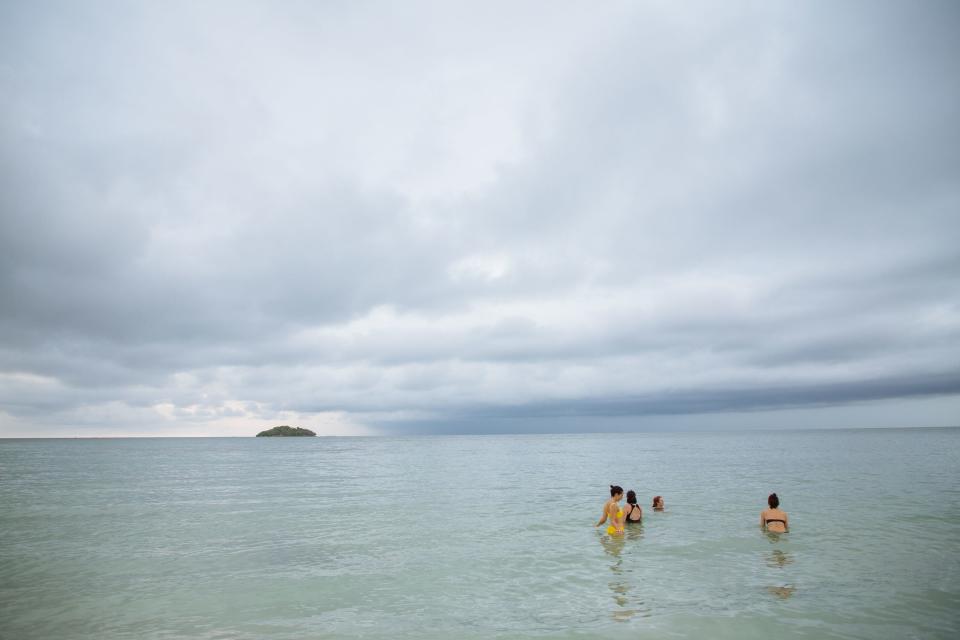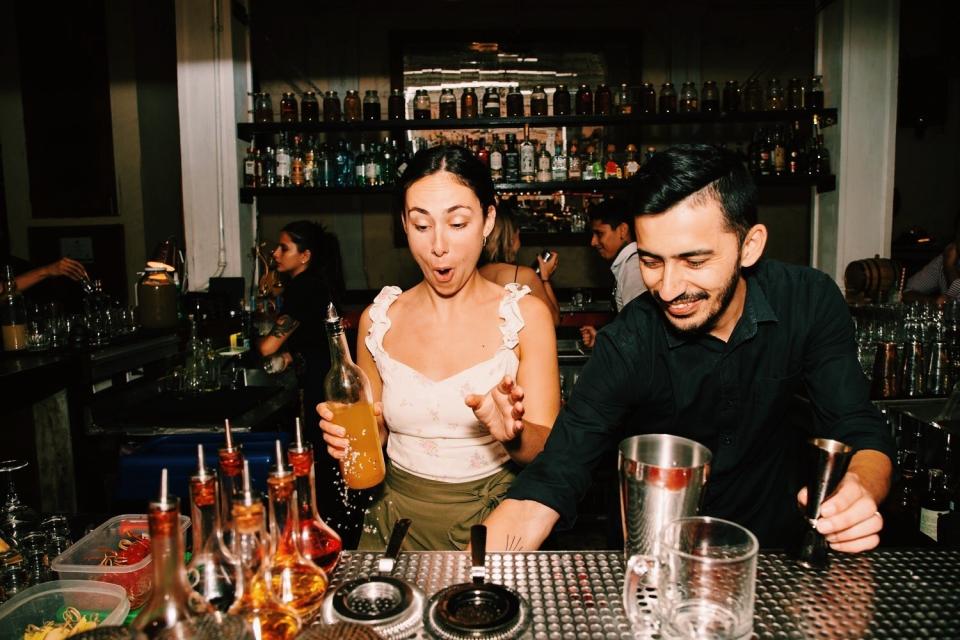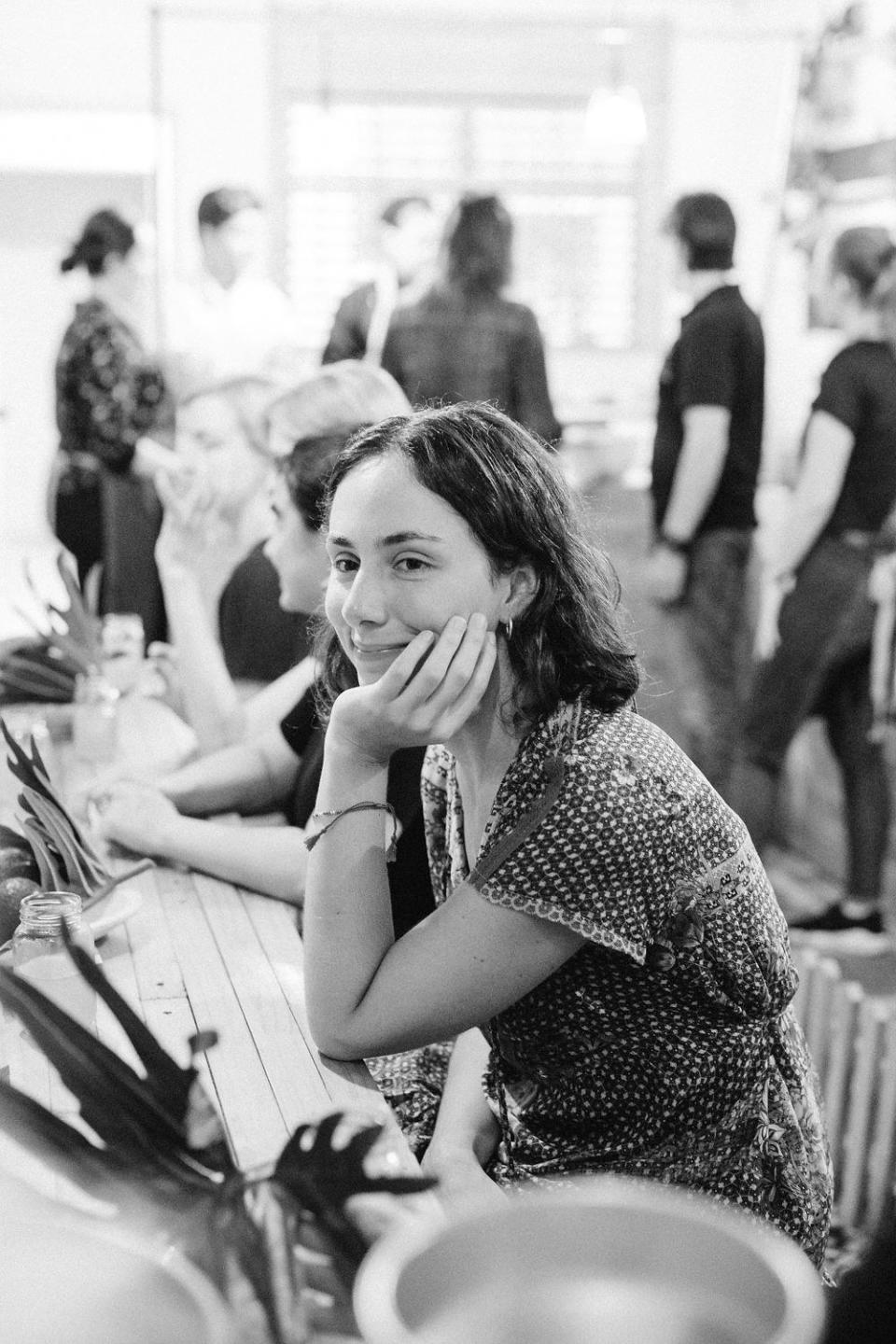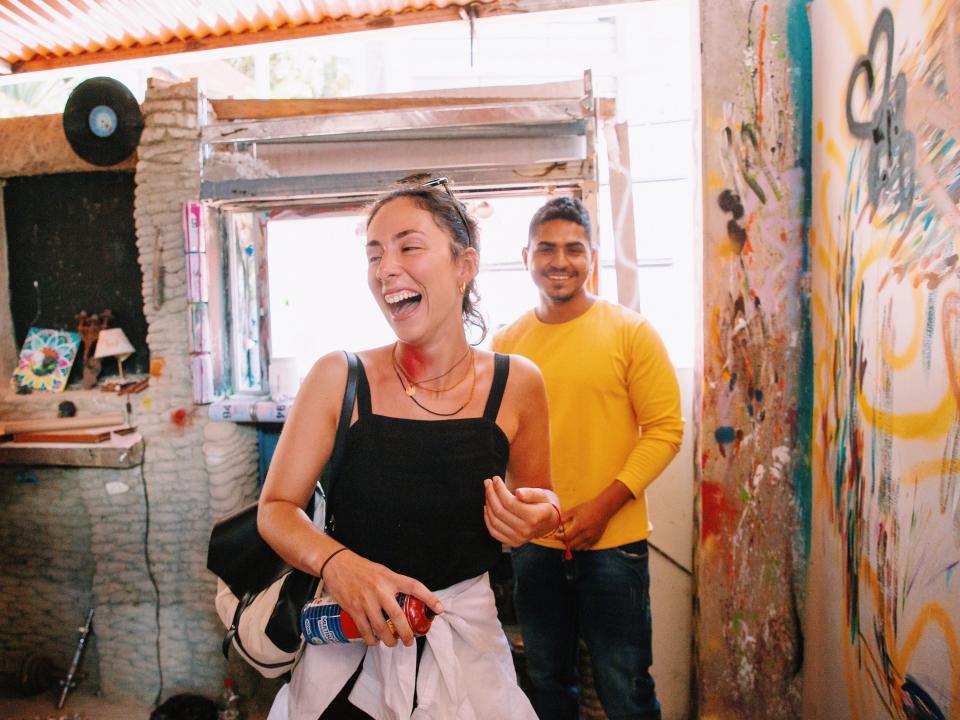The Trip That Taught Me to Be Gentler on Myself
The first time I traveled outside of the country I was a teenager, alone on a five-week homestay program in Turkey. I landed in Istanbul, was greeted by my perfectly warm, welcoming, and lovely host family, and fell into a cycle of overwhelming anxiety that lasted 10 days straight. This wasn’t what I would call new for me—I was an anxious kid, had my first panic attack when I was eight, and started therapy not long after. By the time I got to Turkey, I should have been great at having (and handling) anxiety. But every panic attack felt just as terrifying as my first. And alone in Turkey, even though I knew plenty of breathing techniques and coping mechanisms, none of them were working.
To make the whole situation even more unpleasant, I was furious at myself for my inability to feel happy. I was in Turkey! I was living the adventurous life! Why couldn't I just relax? Anxiety brings about a particular kind of sadness; you really, really wish you did not feel it, but you do.
I decided that my self-prescribed treatment plan should include a mandatory reading of Elizabeth Gilbert’s travel memoir, Eat Pray Love. I hoped that it would cure me of my angst like medicine, by filling me in on the secret to being happy and relaxed and stress-free so that I could do it too.
And I found exactly what I was looking for, right there in Chapter 13: “Truthfully, I’m not the best traveler in the world,” Gilbert writes. I believe I audibly gasped. She continues: “I know this because I’ve traveled a lot and I’ve met people who are great at it. Real naturals.” And later on, my personal favorite: “Oh, the woes that traveling has inflicted on my digestive tract!”
It was a moment of bittersweet relief: I didn’t have to be good at traveling to do it! But also I knew then for sure and was resigned to the fact that I was guaranteed to be bad at it. Because if Elizabeth Gilbert isn’t good at traveling, who is? Certainly not me.
Since then I’ve had similar experiences with traveling—it is something I make an effort to do as much as I can, but going somewhere new is always somewhat of a masochistic endeavor. Traveling is hard for an anxious person. It is full of unknowns—the toilet situation, the food situation, the weather situation, and the overall level-of-comfort situation. Pretty much any anxious person's worst nightmare.
Fast forward to a few months ago, when I received a note from my editor asking if I was interested in going on a trip with Condé Nast Traveler’s Women Who Travel. I was instantly excited and nauseous. I would spend nine days, expenses largely paid, on a small group trip through Colombia, and would write a story about the experience. It was a dream assignment: I was being sent on a mission to explore a place I’ve never been...to write. Every detail would be figured out for me, and yet in all honesty the first thing I thought of was everything that might go wrong if I went.
Women Who Travel was born out of an editorial package Condé Nast Traveler (a publication also owned by SELF’s parent company, Condé Nast) published for International Women’s Day in 2017. It contained nine Q&As with successful women like Roxane Gay, Padma Lakshmi, and Naomi Campbell, all titled “Why I Travel.” Enthusiastic readers demanded more, so the editorial team created a Facebook group of the same name in which self-identifying women could share stories, offer tips and advice, and support one another in their traveling-while-female adventures. Today the group has upwards of 150,000 members. Traveler has since expanded the brand into a permanent vertical on its website, a podcast, monthly meetups, and most recently small curated group trips planned in partnership with female-founded tour group El Camino Travel. The first trip left for Colombia in February 2019; as of this writing, there have been six trips since—a seventh leaves next weekend, as does the first trip to Mexico. Today, Women Who Travel announced a new Cuba itinerary for 2020 along with more more trips to Colombia and Mexico.

The cost of the Colombia trip is not necessarily for the shallow-pocketed—it is eight nights, nine days, and costs $3,200 (or $3,600 if you choose a trip that includes an editor from the magazine for a more premium experience), and that doesn’t include flights and whatever you want to spend during your free time. The itinerary contains experiences you couldn’t arrange yourself—at least easily—even if you read the Fodor’s guide front to back: a Sunday feast at a local home cooked by a sweet couple who speaks about their experience living in the gentrified barrio Getsemani; a visit to a community drumming school in a small fishing village; a day spent at a private lakeside villa two hours outside of the city. The trip also comes with a professional photographer whose entire job is to follow the group around and document everything for posterity (also known as Instagram). Each morning when travelers wake up, they receive a selection of the previous day’s photos in their inboxes, vetted, edited, and ready for posting.
There were several aspects of the trip I found immediately enticing: I didn't have to do any planning or research whatsoever, as there was an itinerary and a local guide who would shepherd us around the country. I felt safe and comfortable knowing everything was vetted by the Traveler team. I also liked the idea of being what I like to call “alone together” with nine other women; there is nothing worse than feeling obligated to do something with someone in a certain situation just because you know each other. Because I wasn’t going with anyone I knew, I could pivot back and forth between being social and completely isolating myself as necessary without offending anyone. So I tamped down my anxious thoughts and signed up for the trip.
Before I left I met with Megan Spurrell, the community editor at Traveler who oversees various parts of the Women Who Travel brand with a few other editors. Her description of the trip left me feeling even more excited to go. “Our goal is really to attract people who believe in the same things,” she told me. The small group trips have a focus on what Spurrell refers to as “responsible tourism.” “That means the trip is immersive, supports local businesses, and takes travelers to the heart of each destination,” she said, “really marrying the editorial side with what’s happening on the ground.”
As I prepared to leave, it felt surreal that I was going anywhere at all. It is hard to imagine yourself traveling before you go; in fact, imagining yourself traveling is more like remembering yourself traveling. How weird it is to not be able to envision where you’re going, which makes it seem impossible or fantastical that you will ever get there at all. Instead all I can do is recall places I’ve already been, knowing that where I’m going won’t possibly be the same. It is a recipe for an anxiety disaster.
I arrived in the coastal city of Cartagena on a Saturday afternoon. There were 10 of us in the group, a mix of ages and experiences that made us a fun cast of characters. There was a woman my age from Chicago, who by coincidence also worked at Condé Nast, and who I’d eventually bond with the most. There was a mother and daughter from Manhattan, a woman from Copenhagen, a nurse from Norway who was my assigned roommate, a mother from Connecticut, a nurse from Santa Barbara, a British diplomat living in San Francisco, and a lab manager from northern California. You would never have put us together in any other circumstance, but there we were, in Cartagena, Colombia, about to spend nine days together.
That night we met in the lobby as a group for the first time before heading out to a mixology class at Alquimico, a three-story cocktail bar known for its experimental drinks and homemade infusions. Later at dinner—a seven-course tasting menu at Celele, a restaurant that focuses on local biodiversity and gastronomic culture—the exchange of travel stories began. (It turned out many of our conversations would be about traveling. It was, after all, the one thing we had in common.) It seemed like most of the women take one or two big international trips a year, which they plan far in advance and budget to make happen. These were not just women who travel, but women who really love to do it.

I am always fascinated by the question of why someone likes to travel because I'm actually just looking for an answer for myself. If someone asked me, I don’t know what I’d say. Once I arrive at wherever I’m going, I am keenly aware of the possibility that everything I’m afraid of (food poisoning, getting lost, terrorism, civil war, natural disaster) may finally happen. I am also keenly aware of how much time has gone by and how much I have left until I go home. Traveling feels like a race, and I’m a terrible runner. What is there to love about that?
Our second day we took mud baths in Totumo, a centuries-old volcano—or rather we floated in a large pit of seemingly bottomless dreck (it goes to the center of the earth, or so they say) while men rubbed wet clay all over our bodies. After the mud, we made our way back down the rickety wooden steps of the volcano and into a nearby lagoon, where older women dumped buckets of swampy water on our heads and into our bikinis. We took off our swimsuits and they scrubbed our naked torsos like babies in a bathtub. I have never been baptized, but I’d imagine spiritually it would feel something like this.
On the third day in Cartagena, I took a free afternoon to write—another thing I had been anxious about not doing. I wrote down the things I loved about the city: I loved seeing the way other cultures live and do things. I loved the two women who welcomed our group into their house for a homemade lunch (the best meal I had on the trip). I loved wearing no makeup and a comfortable but flattering outfit. I loved seeing other people happy. I loved the food. I loved all the beautiful things, all the tasteful hotel lobbies and bright fruits and painted stucco homes with tiled roofs.
We spent our last day in Cartagena on an island off the coast. I don’t remember how it came up in conversation, but a few of us were lying out on a dock when I casually mentioned that I was an anxious person.
“You are?” Patty, our tall, tan, laid-back, and luminously charismatic guide, asked. “Really? I never would have guessed that about you.”
“Oh yeah, never,” my roommate chimed in. “You seem so...chill.”
“Ha,” I said with a laugh, and sat up to take in the view. I went back to my cyclical train of thought, the hourglass in my head: I love this place, I’m leaving this place, I love this place, I’m leaving.

Our next stop was Medellín, a city most famous for being the center of Pablo Escobar’s drug network in the 1970s and 80s. That was part of the mission of the trip—to rewrite the story of Colombia in a contemporary context. Medellín was cosmopolitan and lush; there were plants and trees everywhere. It was large and spread out, and the area where we stayed, El Poblado, was filled with hipster coffee shops, vegetarian restaurants, and Colombian designer boutiques.
One night a few of us went to dinner at Carmen, one of Medellín’s buzziest restaurants. We started talking about traveling, as we always did. My new friend from Chicago said she loves it because she feels the most like herself when she’s somewhere else. In fact, she feels so much like herself that she feels like an entirely different person, the person that she actually is, when she’s away. She has anxiety everywhere else but here.
“I think the best thing about traveling is the feeling you get at the end of the trip,” I said, finally admitting my deep, dark secret—that it is the relief I get when it’s over that feels the most rewarding.
“I know what you mean,” the lab manager said, smiling. “There is nothing like it.”
I watched my anxiety float by like a speck of dust. It came and then it went every once in awhile, until it came and went again, but I was OK.
On our last day we toured Comuna 13, the area that made Medellín “the most dangerous city in the world,” as described in a 1988 Time article. Today, Comuna 13 has transformed but not gentrified. It’s a symbol of rebirth, and tourists come to see the houses stacked on top of each other up a hillside and the street art that decorates nearly every blank surface.
Our tour guide, Santiago, led us through the district. We saw the murals, ate homemade ice mango pops, and stopped at a site where a child was shot and killed less than 10 years ago. Since then, he told us, the government has built a slide in the ground next to a stairway. “It is so that children will never stop playing here,” he said.
Santi brought us to his mother’s house for lunch. His brother Chota, one of Comuna 13’s most well-known street artists, sat down to join us. I imagined him to be a mysterious Banksy-type figure, but it turned out that he is a friendly community leader with eyelashes I would personally die for. Beneath his mother’s house is a family-run café that sells beer and coffee and prints of Chota’s work.
Chota invited us into his studio. He demonstrated the difference between lines made with small, medium, and large nozzles, spray painting onto a blank wall. Then he held out cans of paint, summoning us to try it ourselves.
A few years prior, I spent some time reporting a piece on a graffiti writer in New Jersey, so I felt fairly confident in my knowledge of graffiti culture. I stepped up to Chota and opted for the red aerosol can and the medium-sized nozzle. He motioned for me to shake the can first; I shook. I held it out in front of me, as Chota had demonstrated. Now test it, he indicated, with a tiny motion of his finger. Again, I set out to mimic him. Test it, I said to myself in my head. I applied a bit of pressure, the can out in front of me, and before I knew it, I had sprayed myself directly in the face.
I jumped back in shock, laughing and crying. My neck was covered in red. Everyone was laughing, possibly more at me than with me, but I didn’t care. “Como me llavo?” I asked Chota in Spanish (how to clean myself).
“Solo con tiempo,” Chota said, shrugging, which meant, to my dismay, “Only with time.”

I had one job, and it was to write my name on the wall of one of the most famous street artists in Medellin, and I had failed miserably. But I was giddy, like a kid. I am sure that I got more pleasure from screwing up than I ever would have from getting it right.
The point of traveling, I believe I have learned, is that you do not need to be a perfect traveler to do it, nor do you need to be good at it to genuinely like it. Going on this trip—one that had all the comforts of luxury group travel, and yet one that still challenged me at moments—showed me that I'm allowed to love travel on my own terms. I can love something even if I don't think I'm that great at it.
So yes, I am sort of bad at traveling. I am anxious, I don’t fully unplug, I make mistakes, and I avoid risk. But the important thing is that I travel—and love to travel—despite that. I guess that’s the reason why people do it: We may have homes, families, friends, and routines, but because there is a whole world out there we willfully leave for the great unknown, even if the unknown sometimes makes us anxious. I have made that decision several times, and I have yet to regret it once.
And thankfully, Chota was wrong. That afternoon, as we all prepared to leave Colombia, I took a shower before heading to the airport. The spray paint came right off.
Related:
16 Ways to Stay Mentally Healthy When You Travel A LOT, From People Who Do It
7 Steps I Took to Afford Taking a Year Off to Travel the World
12 Awesome Hotels to Add to Your Wellness Travel Bucket List
Originally Appeared on Self

